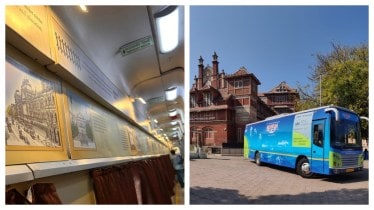The very thought of a museum makes you imagine towering buildings, echoing corridors, and rows of carefully lit glass cases. Apart from this, there is travel, time, and tickets required to make the visit worth it. What if this museum can come to your doorstep with history rolling into schools, marketplaces, and community centres.
How they work
Museum on Wheels, a travelling exhibition model, is reimagining how people experience culture. From India to America, the streets of Brazil to refugee camps in the Middle East, mobile galleries are breaking down barriers and taking art, science, and history directly to people.
As the name suggests, museum on wheels is a specially designed vehicle, usually a bus, van, or trailer, that doubles as a miniature museum. Visitors can quickly glance at the exhibition panels, interactive screens, scale models, and climate-controlled cases for fragile artefacts. The purpose is simple: instead of expecting people to come to a museum, the museum goes to them.
Recently, the Sealdah Division of Eastern Railway transformed the first AC coach of the Sealdah Rajdhani Express into a mobile museum called ‘A Tale of Two Capitals.’ While this initiative celebrates the train’s 25th anniversary this year, offering passengers a cultural journey through the shared history of Kolkata and Delhi, the coach features visuals of reformers like Raja Ram Mohan Roy, Swami Vivekananda, and Rabindranath Tagore, along with landmarks like the Victoria Memorial and Delhi’s Government House. The aim is to enrich the travel experience with a cultural deep dive, highlighting the bond between the two cities, making the journey a memorable experience for passengers.
However, the concept in India was pioneered by the Chhatrapati Shivaji Maharaj Vastu Sangrahalaya (CSMVS) in Mumbai with one of the country’s first ‘Museum on Wheels’ initiatives started in 2015. A refurbished city bus was transformed into a mobile gallery and sent on journeys across Maharashtra. It carries exhibitions on Indian independence, biodiversity, folk traditions, and contemporary issues like climate change across small towns, tribal schools, and villages throughout Maharashtra, Goa, Gujarat, and Karnataka, showcasing artifacts and educational content to diverse audiences, especially where children have never stepped inside a museum before. To ensure accessibility, all exhibitions are bilingual, objects are interactive, and trained educators facilitated workshops and demonstrations.
This month, Mumbai’s double-decker bus gets a rolling museum. An Ashok Leyland Routemaster-style bus has been restored and repurposed as a walk-through museum this year. The bus series 4007/BM/A is renamed ‘Sangrahika’. Curated by Yatin Pimpale, Brihanmumbai Electric Supply and Transport Undertaking (BEST) Museum’s curator, and assistant Ambadas Garje, with support from BEST’s technical teams, the bus showcases rich history of public transport with a gallery exhibiting memorabilia, tracing the evolution of double-deckers in Mumbai and India and its association with Bollywood.
Global phenomenon
This year, the Brooklyn Museum in New York, has launched its Museum on Wheels in a custom-designed Airstream trailer. Painted with bold, eye-catching designs, the trailer travels across Brooklyn neighbourhoods, offering art-making sessions, storytelling programmes, and tactile exploration of objects from the museum’s teaching collection.
Other US museums have experimented with similar concepts. The Smithsonian Institution has supported travelling ‘pop-up museums’ in vans, designed to reach rural schools across states like West Virginia and Montana. Natural history museums in California have used trucks carrying replica dinosaur bones, fossils, and interactive science exhibits, allowing children to touch and learn from objects that would normally remain behind glass.
The UK has seen ‘library buses’ evolve into broader cultural carriers, where art collections and history exhibitions accompany books on tour through rural communities. In Germany, several regional museums operate Kunstbus (art buses) that travel to villages with rotating exhibitions and workshops. In Scandinavia, museum buses often double as science laboratories. Norway has sent mobile ‘science trucks’ into Arctic communities, where children can experiment with chemistry kits or explore models of Viking artefacts.
Why do such museums matter? The rolling museums remind us that learning can still be tactile, communal, and deeply human. They create moments of wonder on street corners and schoolyards, turning an ordinary day into a cultural encounter. These museums have been shown to improve school children’s engagement with subjects like history and science, encourage cross-generational dialogue, and create new platforms for local storytelling.
